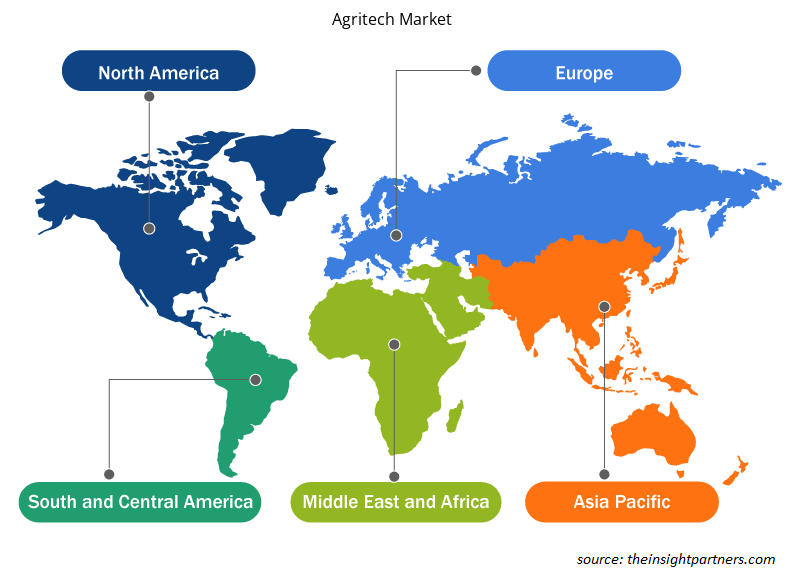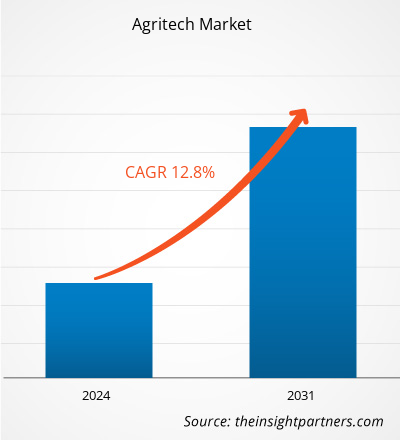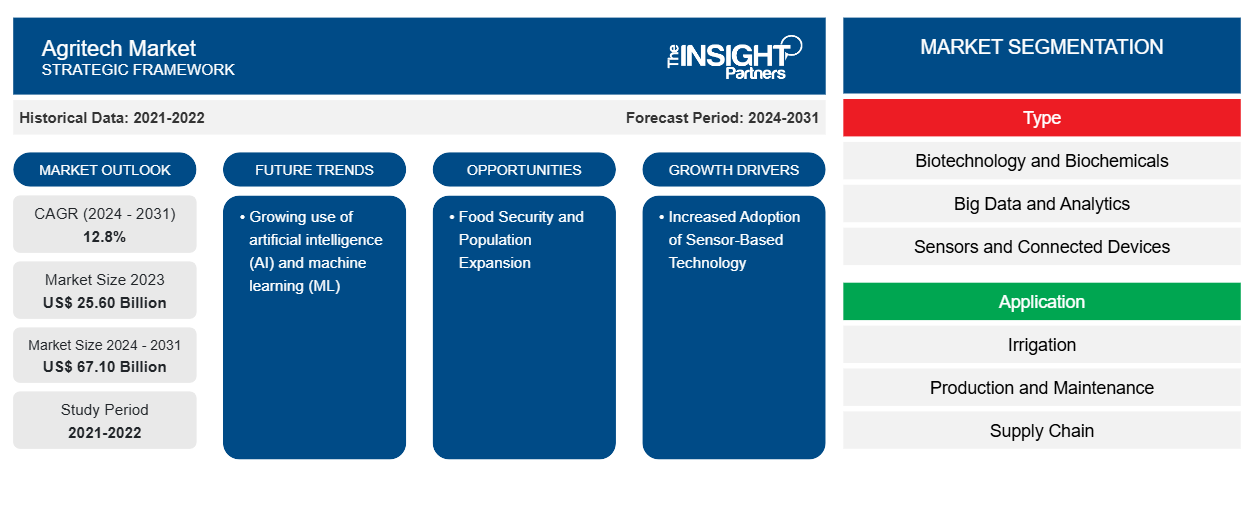Se espera que el tamaño del mercado global de tecnología agrícola crezca de 25.600 millones de dólares en 2023 a 67.100 millones de dólares en 2031; se anticipa que se expandirá a una CAGR del 12,8% entre 2024 y 2031. Es probable que el uso creciente de la inteligencia artificial (IA) y el aprendizaje automático (ML) siga siendo una tendencia clave del mercado de tecnología agrícola.
Análisis del mercado de tecnología agrícola
La adopción de tecnología agrícola basada en sensores, junto con el creciente número de nuevas empresas de tecnología agrícola, es un factor importante que impulsa el crecimiento del mercado de tecnología agrícola.
Panorama general del mercado de tecnología agrícola
La tecnología agrícola o agritech se refiere a la aplicación de avances técnicos en la agricultura para mejorar la productividad, la eficiencia y la rentabilidad. Esto implica aprovechar la tecnología para acelerar la siembra, desarrollar cultivos que prosperen en una variedad de entornos y cosechar . También puede referirse a la utilización de robótica, big data, inteligencia artificial o cualquier otro medio esencial para abordar los problemas que enfrenta el negocio agrícola. Además, la tecnología agrícola se utiliza para crear software de vanguardia basado en Internet de las cosas que puede rastrear y brindar información precisa sobre el clima, la calidad del suelo y el estado actual. Las tecnologías de IoT se utilizan en la agricultura para optimizar la agricultura sin agotar los recursos ni el tiempo de los agricultores, proporcionándoles información en tiempo real sobre sus cultivos y granjas.
Personalice este informe según sus necesidades
Obtendrá personalización en cualquier informe, sin cargo, incluidas partes de este informe o análisis a nivel de país, paquete de datos de Excel, así como también grandes ofertas y descuentos para empresas emergentes y universidades.
- Obtenga las principales tendencias clave del mercado de este informe.Esta muestra GRATUITA incluirá análisis de datos, desde tendencias del mercado hasta estimaciones y pronósticos.
Factores impulsores y oportunidades del mercado de tecnología agrícola
Mayor adopción de tecnología basada en sensores para favorecer el mercado
El aumento del uso de tecnologías basadas en sensores está impulsando el gasto tecnológico en la industria agrotecnológica. Esto implica la utilización de dispositivos de detección y tecnología de Internet de las cosas (IoT). Estas tecnologías permiten a los agricultores recopilar datos sobre una variedad de parámetros, incluidos los patrones climáticos, las condiciones del suelo y el rendimiento de los cultivos, lo que les permite tomar decisiones más informadas. Los sensores instalados en los campos ofrecen a los agricultores información en tiempo real sobre la humedad, la temperatura y la acidez del suelo. Esta información permite a los agricultores tomar decisiones rápidas sobre el riego, el suministro de nitrógeno y la protección de los cultivos.
Seguridad alimentaria y expansión demográfica
El crecimiento demográfico está ejerciendo presión sobre la red mundial de suministro de alimentos. La tecnología agrícola intenta satisfacer las necesidades nutricionales de la creciente población. La siembra y la cosecha de precisión son posibles gracias a tecnologías como los drones y los tractores guiados por GPS, que reducen los costos de los insumos y el impacto ambiental. Además, las soluciones basadas en datos brindan a los agricultores información valiosa sobre los patrones climáticos, las condiciones del suelo y el rendimiento de los cultivos, lo que les permite tomar decisiones informadas.
Análisis de segmentación del informe del mercado de tecnología agrícola
Los segmentos clave que contribuyeron a la derivación del análisis del mercado de tecnología agrícola son el tipo y la aplicación.
- Según el tipo, el mercado se divide en biotecnología y bioquímicos, big data y analítica, sensores y dispositivos conectados, movilidad y otros. El segmento de biotecnología y bioquímicos tuvo una mayor participación de mercado en 2023.
- En términos de aplicación, el mercado se divide en riego, producción y mantenimiento, cadena de suministro y mercado. El segmento de producción y mantenimiento tuvo una mayor participación de mercado en 2023.
Análisis de la cuota de mercado de tecnología agrícola por geografía
El alcance geográfico del informe de mercado de Agritech se divide principalmente en cinco regiones: América del Norte, Asia Pacífico, Europa, Oriente Medio y África, y América del Sur/América del Sur y Central. América del Norte dominó el mercado de Agritech en 2023. El crecimiento del mercado regional se puede atribuir a la creciente adopción de la agricultura de precisión. La tecnología agrícola de precisión, como los drones, los sistemas basados en sensores y los tractores guiados por GPS, ha sido ampliamente adoptada en América del Norte. Esta tecnología permite a los agricultores maximizar el rendimiento de los cultivos, reducir los costos de los insumos y mejorar la productividad agrícola general. Las tecnologías de agricultura de precisión, incluidos los drones, los sistemas basados en sensores y los tractores guiados por GPS, han revolucionado la industria agrícola. Al utilizar estas tecnologías, los agricultores pueden lograr una mayor eficiencia y productividad en sus operaciones.
Perspectivas regionales del mercado de tecnología agrícola
Los analistas de Insight Partners explicaron en detalle las tendencias y los factores regionales que influyen en el mercado de tecnología agrícola durante el período de pronóstico. Esta sección también analiza los segmentos y la geografía del mercado de tecnología agrícola en América del Norte, Europa, Asia Pacífico, Oriente Medio y África, y América del Sur y Central.

- Obtenga los datos regionales específicos para el mercado de tecnología agrícola
Alcance del informe de mercado de tecnología agrícola
| Atributo del informe | Detalles |
|---|---|
| Tamaño del mercado en 2023 | US$ 25.60 mil millones |
| Tamaño del mercado en 2031 | US$ 67,10 mil millones |
| CAGR global (2024 - 2031) | 12,8% |
| Datos históricos | 2021-2022 |
| Período de pronóstico | 2024-2031 |
| Segmentos cubiertos | Por tipo
|
| Regiones y países cubiertos | América del norte
|
| Líderes del mercado y perfiles de empresas clave |
|
Densidad de actores del mercado: comprensión de su impacto en la dinámica empresarial
El mercado de tecnología agrícola está creciendo rápidamente, impulsado por la creciente demanda de los usuarios finales debido a factores como la evolución de las preferencias de los consumidores, los avances tecnológicos y una mayor conciencia de los beneficios del producto. A medida que aumenta la demanda, las empresas amplían sus ofertas, innovan para satisfacer las necesidades de los consumidores y aprovechan las tendencias emergentes, lo que impulsa aún más el crecimiento del mercado.
La densidad de actores del mercado se refiere a la distribución de las empresas o firmas que operan dentro de un mercado o industria en particular. Indica cuántos competidores (actores del mercado) están presentes en un espacio de mercado determinado en relación con su tamaño o valor total de mercado.
Las principales empresas que operan en el mercado Agritech son:
- Tecnología ARSR
- Granjas Aero
- Agricultura Apolo
- Crofarm Agriproducts Pvt Ltd
- Conservar
- Índigo Ag, Inc.
Descargo de responsabilidad : Las empresas enumeradas anteriormente no están clasificadas en ningún orden particular.

- Obtenga una descripción general de los principales actores clave del mercado de tecnología agrícola
Noticias y desarrollos recientes del mercado de tecnología agrícola
El mercado de tecnología agrícola se evalúa mediante la recopilación de datos cualitativos y cuantitativos a partir de investigaciones primarias y secundarias, que incluyen publicaciones corporativas importantes, datos de asociaciones y bases de datos. A continuación, se incluye una lista de los avances del mercado:
- En enero de 2024, Apollo Agriculture, una plataforma agrícola comercial que ayuda a los pequeños agricultores a maximizar sus ganancias, obtuvo una financiación de 10 millones de dólares para respaldar su crecimiento continuo. La startup keniana, fundada en 2019, ofrece a los agricultores acceso a financiación, insumos agrícolas de alta calidad, seguros y asesoramiento optimizado para aumentar su rentabilidad. La reciente financiación permitirá a Apollo Agriculture ampliar sus operaciones en Kenia y ayudar a más agricultores a prosperar, adaptarse al cambio climático y contribuir a la seguridad alimentaria.
(Fuente: Apollo Agriculture, comunicado de prensa, 2024)
- En febrero de 2023, AeroFarms, una corporación B certificada y líder mundial en agricultura vertical en interiores, presentó AeroFarms AgX, su última granja vertical en interiores de última generación. Esta instalación de vanguardia se centra en la investigación y el desarrollo (I+D) innovadores y está ubicada en los Emiratos Árabes Unidos, específicamente en Abu Dabi. AeroFarms AgX tiene como objetivo promover la agricultura en ambiente controlado (CEA) sostenible y la agricultura vertical en interiores para abordar desafíos más amplios de la cadena de suministro agrícola global.
(Fuente: AeroFarms, comunicado de prensa, 2023)
Cobertura y resultados del informe sobre el mercado de tecnología agrícola
El informe "Tamaño y pronóstico del mercado de tecnología agrícola (2021-2031)" proporciona un análisis detallado del mercado que cubre las siguientes áreas:
- Tamaño del mercado y pronóstico a nivel global, regional y nacional para todos los segmentos clave del mercado cubiertos bajo el alcance
- Dinámica del mercado, como impulsores, restricciones y oportunidades clave
- Principales tendencias futuras
- Análisis detallado de las cinco fuerzas de Porter y PEST y FODA
- Análisis del mercado global y regional que cubre las tendencias clave del mercado, los principales actores, las regulaciones y los desarrollos recientes del mercado.
- Análisis del panorama de la industria y de la competencia que abarca la concentración del mercado, el análisis de mapas de calor, los actores destacados y los desarrollos recientes
- Perfiles detallados de empresas
- Análisis histórico (2 años), año base, pronóstico (7 años) con CAGR
- Análisis PEST y FODA
- Tamaño del mercado, valor/volumen: global, regional y nacional
- Industria y panorama competitivo
- Conjunto de datos de Excel
Informes recientes
Testimonios
Razón para comprar
- Toma de decisiones informada
- Comprensión de la dinámica del mercado
- Análisis competitivo
- Información sobre clientes
- Pronósticos del mercado
- Mitigación de riesgos
- Planificación estratégica
- Justificación de la inversión
- Identificación de mercados emergentes
- Mejora de las estrategias de marketing
- Impulso de la eficiencia operativa
- Alineación con las tendencias regulatorias





















 Obtenga una muestra gratuita para - Mercado de tecnología agrícola
Obtenga una muestra gratuita para - Mercado de tecnología agrícola